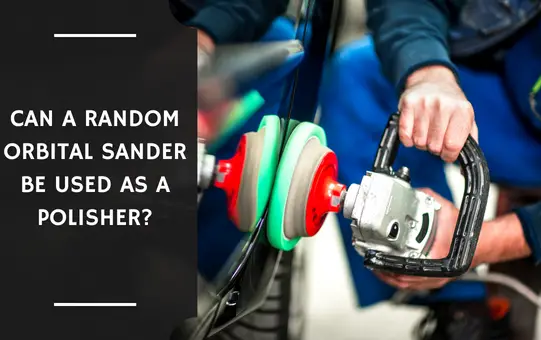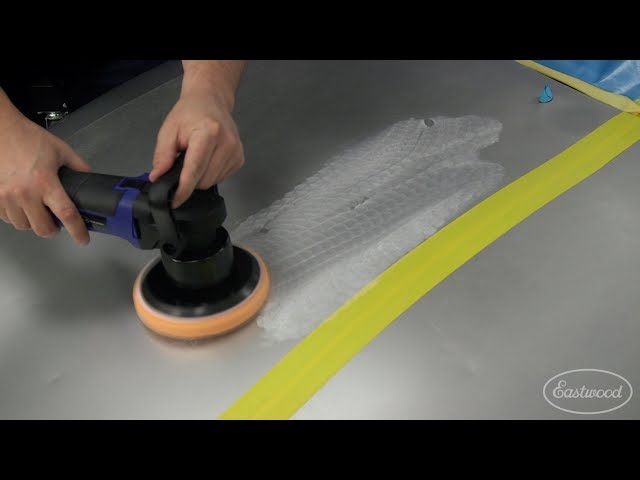Can a random orbital sander be used as a polisher? If you’ve ever wondered about this, you’ve come to the right place! In this article, we’ll explore whether or not you can achieve that shiny, polished finish using a random orbital sander. So grab your safety goggles and let’s dive in!
Now, you might be thinking, “Why would I want to use a random orbital sander as a polisher?” Well, it’s all about versatility and convenience. Random orbital sanders are commonly used for sanding and smoothing surfaces, but can they do double duty as a polisher too? Let’s find out!
So, if you’re ready to uncover the truth behind using a random orbital sander as a polisher, grab a seat and let’s get started. Whether you’re a DIY enthusiast or just curious about power tools, this article will provide all the answers you need. Let’s get polishing!
A random orbital sander can be used as a polisher for certain applications. It provides a dual-action motion that helps in sanding and polishing surfaces. To use it as a polisher, follow these steps:
- Attach a polishing pad to the sander.
- Apply a small amount of polishing compound to the pad.
- Turn on the sander and start polishing with light pressure.
- Work in small sections, moving the sander in circular motions.
- Wipe off any excess compound and inspect the surface for desired results.

Can a Random Orbital Sander Be Used as a Polisher?
When it comes to woodworking or DIY projects, having the right tools is essential. One tool that often comes up in discussions is the random orbital sander. This versatile tool is known for its ability to sand various materials and surfaces. But can it also be used as a polisher? In this article, we will explore this question in detail and provide you with all the information you need to know.
The Difference Between a Sander and a Polisher
Before we dive into whether a random orbital sander can be used as a polisher, let’s understand the difference between the two tools. A sander, as the name suggests, is designed primarily for sanding tasks. It typically uses sandpaper or abrasive discs to remove material from surfaces, creating a smooth and even finish.
On the other hand, a polisher is used to enhance the shine and smoothness of a surface. It is commonly used in automotive detailing to remove imperfections, swirl marks, and oxidation from the paintwork. Polishers often feature different speed settings and use specially designed pads and polishing compounds to achieve a glossy finish.
Can a Random Orbital Sander Be Used for Polishing?
While a random orbital sander is primarily designed for sanding, it can also be used for light polishing tasks. The key lies in the type of backing pad and polishing compound used. By attaching a foam or wool polishing pad to the sander’s hook-and-loop system and using a fine polishing compound, you can achieve decent results in terms of enhancing surface gloss.
However, it’s important to note that a random orbital sander is not a dedicated polisher, and it may not provide the same level of performance as a specialized polishing tool. The circular and random oscillating motion of the sander can make it difficult to achieve a uniform and swirl-free finish, especially on large, flat surfaces. Additionally, the lack of variable speed control on most sanders can limit the control over the polishing process.
To summarize, while a random orbital sander can be used for light polishing tasks, it is not the most suitable tool for achieving professional-grade results. If you require a high-quality, swirl-free finish, it is recommended to invest in a dedicated polisher.
The Benefits of Using a Random Orbital Sander for Polishing
Despite its limitations, there are some benefits to using a random orbital sander for light polishing tasks. Here are a few advantages:
- Cost-Effective: If you already own a random orbital sander, you can save money by using it for occasional polishing tasks instead of purchasing a separate polisher.
- Versatility: A random orbital sander is a versatile tool that can tackle a range of tasks, from sanding to light polishing, allowing you to make the most of your investment.
- Time-Saver: For small-scale polishing projects, using a random orbital sander can be quicker than doing it by hand. The powerful motor and oscillating motion can help you achieve results faster.
Tips for Using a Random Orbital Sander for Polishing
If you decide to use a random orbital sander for polishing, here are a few tips to keep in mind:
- Choose the Right Pad: Opt for a foam or wool polishing pad that is compatible with your sander. These pads are designed to provide a cushioning effect and distribute the polishing compound evenly.
- Use the Correct Polishing Compound: Select a fine-grit polishing compound that is suitable for the material you are polishing. Avoid using compounds that are too aggressive, as they can cause damage.
- Keep the Surface Cool: Polishing generates heat, which can damage the surface. To prevent overheating, periodically check the surface temperature and give it breaks to cool down if needed.
- Work in Small Sections: To achieve a more uniform finish, work in small sections, applying the polishing compound and making multiple passes until the desired level of gloss is achieved.
In Conclusion
While a random orbital sander can be used for light polishing tasks, it is not a substitute for a dedicated polisher when it comes to achieving professional-grade results. However, if you already own a random orbital sander, it can be a cost-effective option for occasional polishing projects where perfection is not the top priority. By following the tips mentioned and managing your expectations, you can successfully utilize your sander for polishing tasks. Just remember, for the best results, consider investing in a quality polisher if you frequently work on polishing projects.
Can a Random Orbital Sander be Used as a Polisher? – Key Takeaways
- Random orbital sanders and polishers are different tools designed for specific tasks.
- A random orbital sander is primarily used for sanding wood surfaces.
- A polisher is used for buffing and shining surfaces, such as cars or countertops.
- Using a random orbital sander as a polisher may damage the surface and produce uneven results.
- It is recommended to use the appropriate tool for each task to achieve the best results and avoid any potential damage.
Frequently Asked Questions
In this section, we will address some common questions related to using a random orbital sander as a polisher.
1. Why would I want to use a random orbital sander as a polisher?
Using a random orbital sander as a polisher can save you time and effort. The random orbital motion of the sander prevents swirl marks and ensures a smooth finish. It can be particularly useful for polishing large surfaces, such as floors or cars. Additionally, if you already have a random orbital sander, using it as a polisher can be a cost-effective option.
However, it’s important to note that a random orbital sander is not specifically designed for polishing tasks. While it can provide satisfactory results, it may not offer the same level of precision and control as a dedicated polisher.
2. Can I use the same sanding pads for polishing with a random orbital sander?
Yes, you can use sanding pads for polishing with a random orbital sander, but it’s recommended to use foam or wool pads specifically designed for polishing. These pads are softer and better suited for distributing polishes and waxes evenly. They are also less likely to cause damage or leave swirl marks on the surface being polished.
It’s important to note that using sanding pads designed for rougher sanding tasks may not yield the desired results in polishing. These pads can be too abrasive and may leave scratches or marks on the surface.
3. Do I need any additional accessories to use a random orbital sander as a polisher?
Yes, you may need some additional accessories to use a random orbital sander as a polisher effectively. One important accessory is a backing plate or pad holder compatible with your sander. This allows you to attach the polishing pads securely to the sander.
You may also need to use different types of polishing pads depending on the surface you are working on. Foam pads are commonly used for general polishing, but wool pads may be more suitable for certain applications. It’s also worth investing in high-quality polishing compounds or waxes for achieving the best results.
4. Are there any limitations to using a random orbital sander as a polisher?
Yes, there are a few limitations to using a random orbital sander as a polisher. While the random orbital motion helps prevent swirl marks, it may not be as effective at removing deep scratches or heavy blemishes. If you have significant imperfections on the surface, using a dedicated polisher or a different sanding technique may be more appropriate.
Additionally, random orbital sanders are typically designed for larger-scale projects, so they may not be the best choice for intricate or detailed polishing work. When working on smaller or delicate surfaces, it’s important to exercise caution to avoid accidentally damaging the object.
5. Can I use a random orbital sander as a polisher on all types of surfaces?
A random orbital sander can be used as a polisher on various surfaces, including wood, metal, plastic, and painted surfaces. However, it’s essential to consider the condition and sensitivity of the surface before proceeding with polishing. Some surfaces may require special considerations or specific polishing techniques.
Always perform a test on a small, inconspicuous area before polishing the entire surface. This allows you to assess the compatibility of the sander and the polishing method with the material you’re working on. If in doubt, consult the manufacturer’s guidelines or seek advice from professionals in the field.

Will It Work : Walmart Hyper Tough Orbital Sander as DA Dual Action Polisher/Car Buffer You Decide
Summary
So, can a random orbital sander be used as a polisher? The answer is yes, but with limitations.
A random orbital sander can be used as a polisher for light to moderate tasks. It can effectively remove swirl marks and fine scratches, giving your car or furniture a smooth and shiny finish. However, it may not be suitable for heavy-duty polishing jobs or for working on delicate surfaces. It is important to use the correct pads and polishes to ensure the best results and to avoid damaging the material. Overall, a random orbital sander can be a handy tool for basic polishing tasks, but for more specialized or demanding projects, it’s best to use a dedicated polishing machine.
